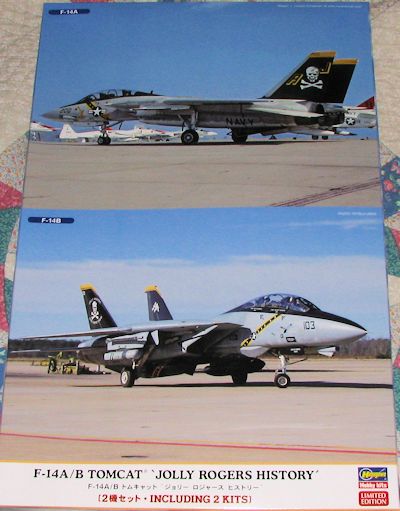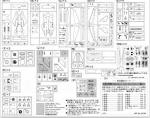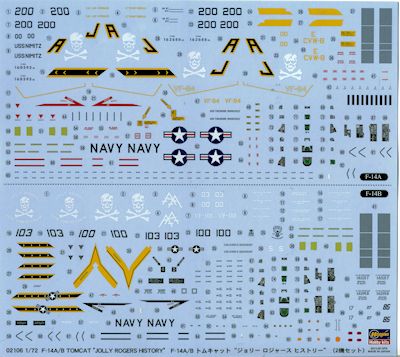
Hasegawa 1/72 F-14A/B Tomcat 'Jolly Rogers History'
| KIT #: | 02106 |
| PRICE: | 5120 yen from HLJ (6400 yen SRP) |
| DECALS: | Four options |
| REVIEWER: | Scott Van Aken |
| NOTES: | 2014 Limited reissue. 2 complete kits |

| HISTORY |
When the Tomcat was first built, it used the same TF-30 engine as used in the F-111. It soon became obvious that this engine was not able to fully take advantage of the Tomcat airframe and soon Grumman developed the F-14B with the same GE engine used in some F-16Cs. While the engine was what the Tomcat really needed, the funding was not there so the project was put on the back burner. Eventually, the loot was available and so began what was know as the F-14A+ with this new engine. Later it was redesignated F-14B. The final variant of the F-14 was the F-14D Super Tomcat. The F-14D variant was first delivered in 1991. The original F-14A engines replaced with GE F110-400 engines, similar to the F-14B. The F-14D also included newer digital avionics systems including a Glass cockpit and replaced the AWG-9 with the newer AN/APG-71 radar. Other systems included the Airborne Self Protection Jammer (ASPJ), Joint Tactical Information Distribution System (JTIDS), SJU-17(V) Naval Aircrew Common Ejection Seats (NACES) and Infrared Search and Track (IRST).
Although the F-14D was to be the definitive version of the Tomcat, not all fleet units received the D variant. In 1989, Secretary of Defense Dick Cheney refused to approve the purchase of any more F-14D model aircraft for $50 million each and pushed for a $25 million modernization of the F-14 fleet instead. Congress decided not to shut production down and funded 55 aircraft as part of a compromise. A total of 37 new aircraft were constructed and 18 F-14A were upgraded to D variants (these were designated as F-14D(R). The R was for rebuild. An upgrade to the F-14D's computer software to allow AIM-120 AMRAAM missile capability was planned but was later terminated.
While upgrades had kept the F-14 competitive with modern fighter aircraft technology, Cheney called the F-14 1960s technology. Despite some aggressive proposals from Grumman for a replacement, Cheney planned to replace the F-14 with a fighter that was not manufactured by Grumman. Cheney called the F-14 a "jobs program", and when the F-14 was canceled, an estimated 80,000 jobs of Grumman employees, subcontractors, or support personnel were affected.
Starting in 2005, some F-14Ds received theROVER III upgrade and were designated as F-14D(R). Of course, this designation only confused things with the rebuilt aircraft, however, since the system was only used for the F-14s final deployment, the whole thing is really moot.
| THE KIT |
 Hasegawa has reboxed the Tomcat at least three or four dozen times, judging by my slowly growing collection of F-14 kits. It was natural that they'd get the most out of what has to have been an expensive molding, judging by the plethora of small parts and inserts that come with the kits. There are so many parts that the box is actually bulging in an attempt tokeep them from escaping. You can see the number of bits and pieces from theimage above. In many ways, this is just a smaller version of the larger andequally impressive 1/48 F-14 that Hasegawa has produced. Typical of Hasegawa,the kit came with all those sprues in two bags. The clear bits are in a separate bag on their own. As a result, there were a numberof parts broken off the sprues and the bits have numerous scratches on them. In order to be sure that we have a proper F-14B, there are bits and pieces to allow this variant to be done. The biggest difference is the exhaust nozzles and the fairings between these and the stabs.
Hasegawa has reboxed the Tomcat at least three or four dozen times, judging by my slowly growing collection of F-14 kits. It was natural that they'd get the most out of what has to have been an expensive molding, judging by the plethora of small parts and inserts that come with the kits. There are so many parts that the box is actually bulging in an attempt tokeep them from escaping. You can see the number of bits and pieces from theimage above. In many ways, this is just a smaller version of the larger andequally impressive 1/48 F-14 that Hasegawa has produced. Typical of Hasegawa,the kit came with all those sprues in two bags. The clear bits are in a separate bag on their own. As a result, there were a numberof parts broken off the sprues and the bits have numerous scratches on them. In order to be sure that we have a proper F-14B, there are bits and pieces to allow this variant to be done. The biggest difference is the exhaust nozzles and the fairings between these and the stabs.
Asdemanded, the panel lines are engraved and the kit offers the ability to havethe flaps and slats deployed. In fact, to do it otherwise will require a bit ofsurgery to be done on the slat tracks. You can also position the glove vanesopen or closed. Again, some surgery is needed for the closed position. All F-14shad them wired in the closed position after it was realized that they didn't really do anything and were an additional maintenance hassle. You also have the ability to have the speed brakes and entrance s As required by its price, this kit comes with a small fret ofetched metal. These bits are for the interior, canopy and exhaust. The metalworkis very well done and should really enhance your Tomcat. For this kit, they supply an instruction sheet dedicated to this boxing . The instructions arevery well done as you would expect. They offer color callouts based on Gunzepaint as is the norm with Hasegawa over  teps/ladderopen or closed, and two different tails, though one set is not for thisparticular boxing. So much has the F-14 been modified and updated over the yearsthat you really need to have photographs of the aircraft that you are modelingto get everything right.
teps/ladderopen or closed, and two different tails, though one set is not for thisparticular boxing. So much has the F-14 been modified and updated over the yearsthat you really need to have photographs of the aircraft that you are modelingto get everything right. the last decades. Every option anddifference between the aircraft on the decal sheet is given so that you can do aproper job of things. Since this is a double kit, you get two of everything and some bits are not required depending on the version you are building.
the last decades. Every option anddifference between the aircraft on the decal sheet is given so that you can do aproper job of things. Since this is a double kit, you get two of everything and some bits are not required depending on the version you are building.
For markings, we have options for four planes. Two of them are for the F-14A with VF-84. Both are CAG birds with one in light gull grey and white aboard the USS Nimitz in 1978. The other is overall light gull grey aboard the USS Theodore Roosevelt in 1989. For the F-14Bs we have both in the TPS with VF-103. First one is aboard the USS John F Kennedy in 2004 while the second is the CAG bird on the same ship and date. The instructions are quite explicit as to which bits go with which version. Decals are very nicely printed and should be no issue. Paint information is, of course, by Gunze and offers FS 595 equivalents.
| CONCLUSIONS |
You can add this one to a growing list of Hasegawa limited reissue kits. I guess it is a good way to do business as they seem to sell rather well. I'm surprised at how well these molds have held up and the Jolly Rogers seem to be one of the more popular schemes so this set should sell well to fans. The final result of the build are a pair of superb models of an important US fighter.
| REFERENCES |
http://en.wikipedia.org/wiki/F-14_Tomcat
June 2014
My thanks to Hobby Link Japan for the preview kit. You can get this kit at this link.
If you would like your product reviewed fairly and fairly quickly, please contactme or see other details in the